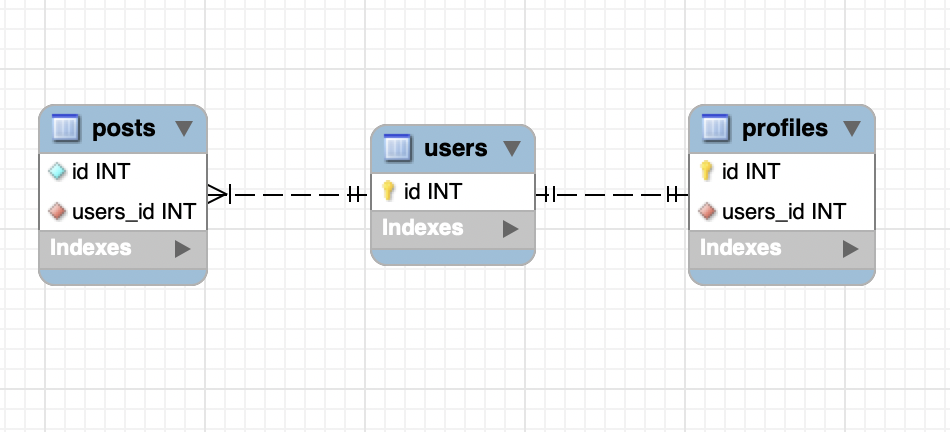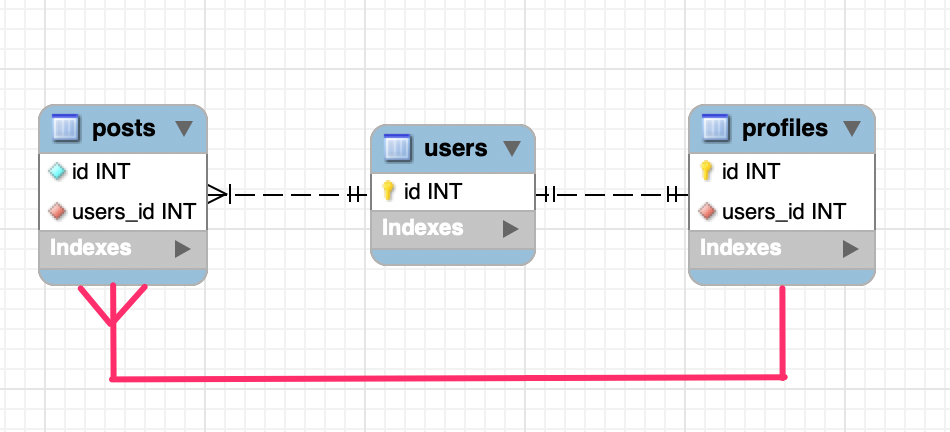- 公開日
ActiveRecordでhas_oneを持ったモデルをスキップして関連を定義する方法

目次
テーブル構成
とあるRailsアプリケーションでこんなテーブル構成があったとします。

Railsモデル定義
Railsモデルは下記のような状態です。
- ユーザー(
User)は複数の記事(Post)データをもっている - ユーザー(
User)は1つのプロフィール(Profile)データをもっている
class User < ApplicationRecord
has_many :posts
has_one :profile
end
class Post < ApplicationRecord
belongs_to :user
end
class Profile < ApplicationRecord
belongs_to :user
end
モデルの生成コマンド(rails generate コマンド)は下記の通りです。
$ rails g model User
$ rails g model Post user:references
$ rails g model Profile user:references
has_oneをもったモデルをスキップする
やりたいこととしてはこのモデル構成の中心にいる User の関連をスキップして Post と Profile を直接関連付けてやることです。つまり User has_one Profile, User has_many Posts の関係を、Profile has_many Posts の関係にしちゃおう、ということです。
テーブル定義で表現すると下図の赤線の部分が今回やりたい関連の定義です。

モデル定義
上記のやりたいことはアソシエーションの定義において、foreign_key, primary_key などのオプションを駆使して実現可能です。
下記がそのアソシエーション定義の完成形となります。
class User < ApplicationRecord
has_many :posts
has_one :profile
end
class Post < ApplicationRecord
belongs_to :user
belongs_to :profile, foreign_key: :user_id, primary_key: :user_id
end
class Profile < ApplicationRecord
belongs_to :user
has_many :posts, foreign_key: :user_id, primary_key: :user_id
end
この定義により Post → Profile, Profile → Post の双方向の関連付けが定義することができました。
> Post.first.profile
# Post Load (1.2ms) SELECT `posts`.* FROM `posts` ORDER BY `posts`.`id` ASC LIMIT 1
# Profile Load (3.9ms) SELECT `profiles`.* FROM `profiles` WHERE `profiles`.`user_id` = 1 LIMIT 1
=> #<Profile id: 1, user_id: 1, ...">
> Profile.first.posts
# Profile Load (0.8ms) SELECT `profiles`.* FROM `profiles` ORDER BY `profiles`.`id` ASC LIMIT 1
# Post Load (0.4ms) SELECT `posts`.* FROM `posts` WHERE `posts`.`user_id` = 1 LIMIT 11
=> #<ActiveRecord::Associations::CollectionProxy [#<Post id: 1, user_id: 1, ...">, #<Post id: 2, user_id: 1, ...]>
上結果の通り、User Loadを通すことなくお互いを呼び出すことができていることが確認できました。
inverse_of を設定する
上記のコードでやりたいことが実現できましたが、まだ1つだけ問題があります。それは foreign_key オプションを使っているために、双方向の関連付けが不完全に設定されていることです。
Active Recordでは標準的な名前同士の関連付けのほとんどをサポートしていて、自動的に認識できます。ただし、Active Recordでスコープや次のオプションを使った場合、双方向の関連付けは自動的に認識されません。
:through:foreign_key
via. Active Record の関連付け - Rails ガイド
実際に試してみましょう。すると下記の通り、同じidを持ったインスタンスにもかかわらず違うオブジェクトとして生成されていることがわかります。
> profile1 = Profile.first
=> #<Profile id: 1, user_id: 1, ...">
> profile2 = profile1.posts.first.profile
=> #<Profile id: 1, user_id: 1, ...">
> profile1.equal? profile2
=> false
モデル定義(inverse_of version)
これを解決するために inverse_of を設定します。上述のコードを下記のように変更します。
class User < ApplicationRecord
has_many :posts
has_one :profile
end
class Post < ApplicationRecord
belongs_to :user
belongs_to :profile, foreign_key: :user_id, primary_key: :user_id, inverse_of: :posts
end
class Profile < ApplicationRecord
belongs_to :user
has_many :posts, foreign_key: :user_id, primary_key: :user_id, inverse_of: :profile
end
これで下記コードは同じオブジェクトとなり、trueを返すようになります。
> profile1 = Profile.first
> profile2 = profile1.posts.first.profile
> profile1.equal? profile2
=> true